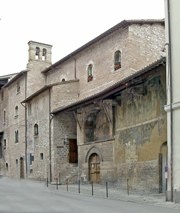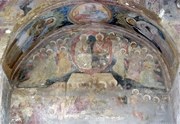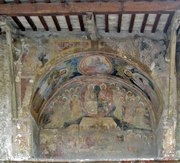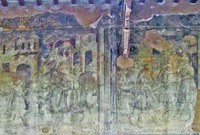

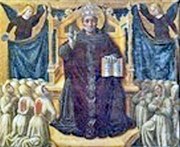
Detail of the gonfalon (1468) of the Confraternita di San Gregorio
by Nicolò di Liberatore, l' Alunno, Staatliche Kunsthalle, Karlsruhe
Bishop Teobaldo Pontano (1296-1329) encouraged the formation of confraternities in Assisi, during the long period of interdict, which began in 1320. Membership of one of these penitent organisations allowed people to access the sacraments and to be buried in consecrated ground.
The earliest surviving statutes of one of these confraternities are those of the Confraternita di Santo Stefano, which date to 1326. The Confraternita di San Gregorio is mentioned in them, along with other, unspecified confraternities. The statutes of the Confraternita di San Lorenzo survive from 1329.
Confraternities listed in a liturgical document of 1329 were those dedicated to Santa Maria [delle Rose], San Rufino, and: Sant’ Antonio, Sant’ Antonino, Santa Chiara, San Francesco, and San Pietro.
Bishop Nicolò Sermattei suppressed the a number of confraternities in 1772 and diverted their income to the Diocesan Seminary.
All of the surviving confraternities were suppressed in 1860, or soon after.
Confraternita di Sant' Antonino

The confraternity was was first documented in 1329. It acquired the church of Sant' Antonino (12th century), which was dedicated to St Antoniunus of "Pamia" (perhaps Pamiers, France or Apamea, Syria). Only the apse of the church survives, in the garden of Palazzo Aluigi (with its facade hidden by the tree in the centre of this photograph)..
The Oratorio di San Lorenzo (see below) passed to the confraternity in 1772 and remained in its ownership until it in turn was suppressed in 1860.
Confraternita di Santa Chiara

The complex now belongs to the Suore Svedesi di Santa Brigida.

Confraternita di San Francesco
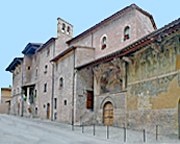
The Confraternita di San Francesco was first documented in 1329. Its oratory, the Oratorio di San Francesco, is also known by three other names:
-
✴di San Francescuccio, to distinguish it from the main church of San Francesco;
-
✴di San Leonardo, the name of the now-demolished church near Porta San Giacomo in which the confraternity originally met; and
-
✴delle Stimmate, after the confraternity became part of the Arciconfraternita delle Sacre Stimmate, Rome in 1594.
For more detail, see the page on the Oratorio di San Francesco (illustrated here).
Confraternita di SS Giacomo e Antonio Abate
This confraternity was formed from two, originally distinct, organisations:
-
✴The Confraternita di Sant’ Antonio was first documented in 1329 and met in the church of Sant’ Antonio Abate (see below).
-
✴The “societa s. Iacobi” was first documented in 1372, at which point is was a society dedicated to helping those who wished to make a pilgrimage to Santiago di Compostella. It also gave hospitality to pilgrims visiting Assisi. In 1417, it acquired land on which to build a hospice (the Ospedale dei Pellegrini), which was completed in 1422.
From 1425, the hospice was known as the Ospedale di SS Giacomo e Antonio Abate, which suggests that the Confraternita di Sant’ Antonio was also involved in its administration.
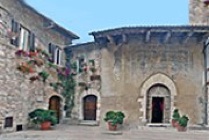
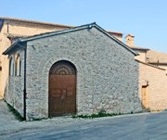

Oratorio dei Pellegrini Sant’ Antonio Abate Santa Caterina
In ca. 1439, the two associations merged to form the Confraternita di SS Antonio e Giacomo.
-
✴The merged confraternity met at Sant’ Antonio Abate until 1595, when it moved to Santa Caterina (where the architrave of the portal bears the name of the confraternity).
-
✴It built the Oratorio dei Pellegrini (1457-67), which probably served as a chapel for pilgrims, next to the Ospedale di SS Giacomo e Antonio Abate. (The hospice was demolished in 1883, but the oratory survives).
The confraternity acquired the Cappella di Sant' Antonio Abate in Santa Maria degli Angeli in 1664.
Confraternita di San Gregorio
According to an inventory that was compiled in 1717 at the request of Bishop Palmerini, the Confraternita di San Gregorio was the first to be formed in Assisi and took precedence over all of the others. Bishop Nicolò Sermattei suppressed the confraternity in 1772.
Original Premises
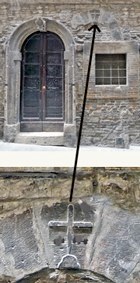
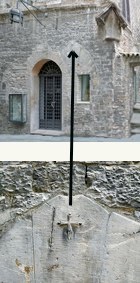
Original oratory Original hospice
Until 1325, the confraternity used premises in what is now Via Fortini:
-
✴The oratory was in the medieval house (restructured in the 17th century) at number 2. When the confraternity moved in 1325 (see below), this became the Oratorio del Crocifisso di San Gregorio. Traces of the original Gothic portal survive , with a tiny Crucifix on its keystone.
-
✴The associated hospice was opposite, at number 3. Traces of the original Gothic portal survive, with a tiny Crucifix on a mountain on its keystone.
Later Premises
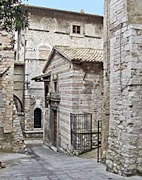
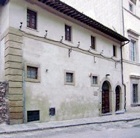
Oratorio di San Gregorio Ex-Ospedale di San Gregorio
Bishop Teobaldo Pontano arranged for its meeting place to be moved to the Oratorio di San Gregorio in 1325. The ex-hospital of the confraternity in Via San Francesco now belongs to the Capuchins of the Oratorio della Immacolata Concezione and houses their Museo degli Indios dell' Amazzonia. The Cappella di San Ludovico in the Lower Church of San Francesco was ceded to the Confraternita di San Gregorio and the Confraternita di Santo Stefano in 1535.
Confraternita di San Lorenzo
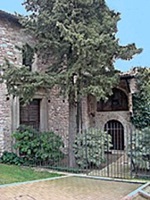
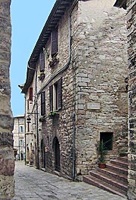
Oratorio di San Lorenzo Ex-Ospedale di San Lorenzo
This confraternity, whose statutes survive from 1329, owned the Oratorio di San Lorenzo, together with a hospice in nearby Via Perlici (see Walk I). Bishop Nicolò Sermattei suppressed it in 1772, and the oratory passed first to the Confraternita di Sant Antonino (see above) and then into private hands in 1860.
Confraternita di Santa Maria del Vescovado
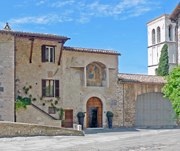
Confraternita di Santa Maria del Vescovado was first documented in 1354 and, by 1426, was also dedicated to St Blaise. Bishop Nicolò Sermattei suppressed the confraternity in 1772. Its oratory later passed to the Confraternita di SS Crispino e Crispiano.
For more detail, see the page on the Oratorio di San Crispino.
Confraternita di San Pietro
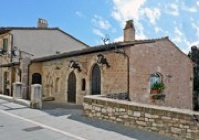
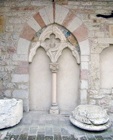
The Confraternita di San Pietro was first documented in 1329 and its hospice (at what is now number 23 Via Fontebella) in 1354. [A corridor that linked it to the Abbazia di San Pietro can be seen in the Museo di San Pietro.
Bishop Nicolò Sermattei suppressed the confraternity in 1772.
Confraternita di San Rufinuccio
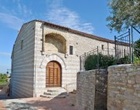
Confraternita di Santo Stefano
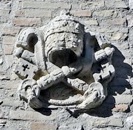

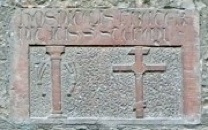
Bishop Teobaldo Pontano gave permission to the confraternity to build the Oratorio and Ospedale di Santo Stefano (1325), at what is now 19-21 Via San Paolo. Its statutes of 1326 survive in the city archives. The main rooms used by the confraternity were at number 21.
-
✴The papal insignia dated 1664 above the portal on the left in the façade suggests that the building was restored at that date: it was remodelled in 1845.
-
✴An inscription "HOSPITALIS FRATERNITAS S STEFANI" above the confraternity's emblem identifies the associated hospice. This can be seen to the right of the entrance to what is now the Ristorante Posta Girarrosto, at number 19.
The Cappella di San Ludovico in the Lower Church of San Francesco was ceded to the Confraternita di San Gregorio and the Confraternita di Santo Stefano in 1535.
Confraternita di San Vitale
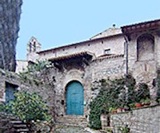
This oratory (late 14th century) originally belonged to the Confraternita di San Vitale, which St Vitalis established on Mount Subasio before 1362. It moved here at the end of the 14th century. Bishop Nicolò Sermattei suppressed it in 1772. The oratory subsequently passed to a community of Franciscan tertiaries. [Recent restoration]
Gonfalone di San Vitale (15th century)
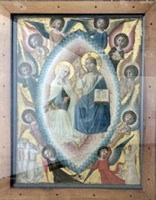

This double-sided standard from the oratory, which is is now in the Pinacoteca Civica, Foligno, is attributed to to Pietro di Giovanni Mazzaforte.
-
✴On one side, the Virgin commends members of the confraternity (three men kneeling at the lower left and a woman kneeling at the lower right) to Christ, who confers his blessing. Both Christ and the Virgin are in a mandorla supported by angels.
-
✴The other side depicts:
-
•the Crucifixion with the Virgin and St John the Evangelist (above); and
-
•the Blessed Vitale surrounded by the kneeling brothers, with SS Francis and Clare. (The Blessed Vitale was a hermit who founded the confraternity in ca. 1362 on Mount Subasio.)
Return to Monuments of Assisi.
Return to Walk I (San Lorenzo; and San Vitale).
Return to Walk II (Santa Chiara; San Francesco; Oratorio di San Gregorio;
Santa Maria del Vescovado; and San Pietro).
Return to Walk III (Sant’ Antonino ; SS Giacomo e Antonio Abate;
the original premises and Ospedale di San Gregorio; San Rufinuccio; Santo Stefano).
Return to the home page on Assisi.

